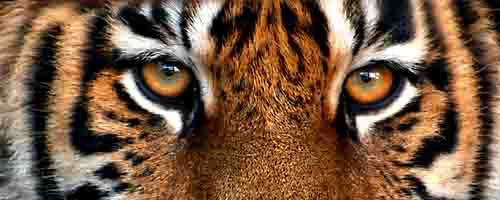


Most people are frightened of tigers. In literature too tigers are depicted as a powerful and dreadful beast. Common misconception is that it is very dangerous and it attacks humans. Misinformation and lack of knowledge about tigers is common resulting in this fright.
Certain features of the tiger are helpful in hunting. Their claws remain embedded in the paw while walking. That helps in their smooth movement and the claws are not injured. While attacking, the claws project out like strong hooks and injure the prey and hold it firmly.
Simultaneously, the tiger uses its jaw to hold the prey using long and pointed canines. This renders the prey immobile and helpless. Their retina reflects the light inside facilitating to see better. Their night vision is six times better than human.
Tiger's pupils are round and the iris is yellow in colour. Only in white tiger it is blue. Tigers' body hairs are sensitive, helping to feel the surrounding even while moving. The two legs of each side move almost together resulting in gliding movement. Hence, the surrounding is not disturbed and almost no sound is produced.
The prey is unable to detect the presence of the tiger in its vicinity and gets caught. Another feature of the tiger is that it can balance its body well while running at full speed. Its tail is moved to balance the body weight like the rope walkers carrying a rod in their hand. Also, the tail is used to transmit signals among each other.
Tiger is large and it needs about 15 to 18 kg of meat/day. Important fact is that chances of the tiger being successful is only 5 to 10%; i.e., in 10 to 20 attempts, the tiger succeeds only once. Obviously, the tiger cannot afford to allow the prey to run away once it is able to catch. It uses all possible means to immobilize the prey.
Life is more difficult for a female tigress, if it has cubs. It has to find food for herself and the cubs. Also, it cannot move freely. Cubs are small (less than 8oog to little more than 1600g) and blind at birth. They are totally dependent on the mother. So, the mother's movements are restricted. Obviously it becomes more ferocious when it finds a prey.
Tigers commonly prey upon different types of deer and wild boar. They kill young elephant or young rhino as well. Occasionally, under compulsion, tigers prey upon monkeys, reptiles, birds and fishes. Tigers and tigresses hunt alone. But tigresses with cubs hunt in groups, which makes their task easy and the cubs get better protected.
Generally, tigers search for prey before the sunset. Often it keeps roaming the entire night and walk up to 25km in search of prey. In dense forests the days are cool. Tigers hunt even during the daytime. During the hot days they take rest in the shade of trees or in some secluded area. They may enter water bodies and remain there till the temperature comes down.
Tigers are the largest animal in the Cat family, weighing up to 300kg. But all varieties are not that big. Siberian tigers are the largest. Earlier, there were eight subspecies of tiger. Now five survive; three-Bali tiger, Javan tiger, and Caspian tiger-are extinct. The South China tiger is critically endangered since 1996 and possibly extinct in the wild. Last confirmed sighting was in the 19905.
By the end of 20th century, only 5000 to 7500 tigers could be estimated.Hence, tiger is in the Endangered category of IUCN (International Union for Conservation of Nature and Natural Resources). According to WWF (World Wide Fund for Nature), by January, 2021 there were only 3890 tigers in the wild.
In 1900 globally, the forest cover was around 4,128 to 5,500 million ha. By 2021 it came down to about 4000 million ha. Shrinking forests denied suitable habitats for the tigers and also deprived them of their prey. Also, water should be available round the year. Hunting area of a tiger may extend to about 700 km2.
If the tiger gets its prey easily, the hunting area may restrict to about 150 km2. When the tigers become weak or they stray outside the forests towards human habitations, they try to prey upon domestic animals and cattle. If they encounter humans, they may attack, but only under compulsion. Otherwise, tigers are shy animals and they avoid approaching humans.
If the tiger is not hungry, it does not bother at all about humans. There have been instances of tigers entering homes during night and sleeping close to the humans. Only when the tigers are deprived of their abode and prey, they come out of the forest and approach human habitations.
That leads to human-tiger conflicts and people consider them as enemy. At times tigers turn man-eaters. Then it becomes essential to capture those tigers and keep them in captivity or to kill them. Most of the researchers say that the tigers turn man-eaters as sufficient numbers of prey are not available.
Author: Jayveer Vala